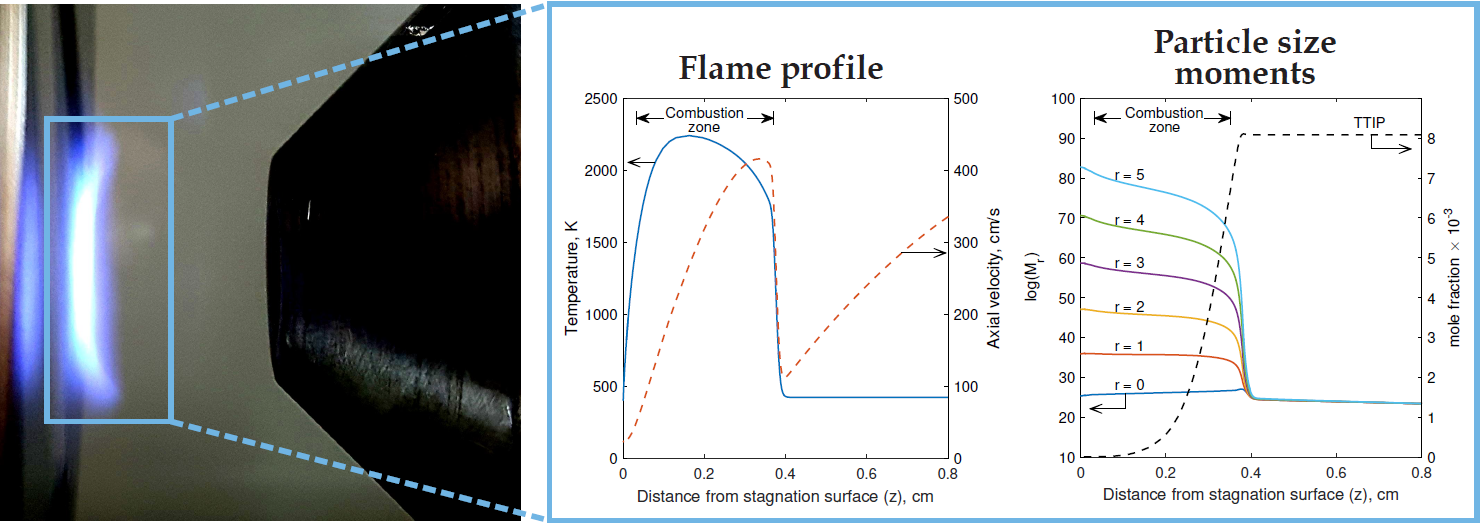Modelling TiO2 formation in a stagnation flame using method of moments with interpolative closure
- Particle population balance model of TiO2 synthesis from titanium tetraisopropoxide (TTIP) is solved using method of moments with interpolative closure (MoMIC).
- A simple reaction model for TTIP decomposition is sufficient to simulate the particle sizes in a flame stabilized on rotating surface (FSRS) experiment.
- Particle size is found to be sensitive to the sampling location near the stagnation surface, especially for high TTIP loading and stagnation temperature.
- Surface growth plays an important role in the initial growth stage of particles.
 The stagnation flame synthesis of titanium dioxide nanoparticles from titanium tetraisopropoxide (TTIP) is modelled based on a simple one-step decomposition mechanism and one-dimensional stagnation flow. The particle model, which accounts for nucleation, surface growth, and coagulation, is fully-coupled to the flow and the gas phase chemistry and solved using the method of moments with interpolative closure (MoMIC). The model assumes no formation of aggregates considering the high temperature of the flame. In order to account for the free-jet region in the flow, the computational distance, H=1.27 cm, is chosen based on the observed flame location in the experiment (for nozzle-stagnation distance, L=3.4 cm). The model shows a good agreement with experimentally measured mobility particle size for stationary stagnation surface with varying TTIP loading, although the particle geometric standard deviation, GSD, is underpredicted for high TTIP loading. The particle size is predicted to be sensitive to the sampling location near the stagnation surface in the modelled flame. The sensitivity to the sampling location is found to increase with increasing precursor loading and stagnation temperature. Lastly, the effect of surface growth is evaluated by comparing the result with an alternative reaction model. It is found that surface growth plays an important role in the initial stage of particle growth which, if neglected, results in severe underprediction of particle size and overprediction of particle GSD.
The stagnation flame synthesis of titanium dioxide nanoparticles from titanium tetraisopropoxide (TTIP) is modelled based on a simple one-step decomposition mechanism and one-dimensional stagnation flow. The particle model, which accounts for nucleation, surface growth, and coagulation, is fully-coupled to the flow and the gas phase chemistry and solved using the method of moments with interpolative closure (MoMIC). The model assumes no formation of aggregates considering the high temperature of the flame. In order to account for the free-jet region in the flow, the computational distance, H=1.27 cm, is chosen based on the observed flame location in the experiment (for nozzle-stagnation distance, L=3.4 cm). The model shows a good agreement with experimentally measured mobility particle size for stationary stagnation surface with varying TTIP loading, although the particle geometric standard deviation, GSD, is underpredicted for high TTIP loading. The particle size is predicted to be sensitive to the sampling location near the stagnation surface in the modelled flame. The sensitivity to the sampling location is found to increase with increasing precursor loading and stagnation temperature. Lastly, the effect of surface growth is evaluated by comparing the result with an alternative reaction model. It is found that surface growth plays an important role in the initial stage of particle growth which, if neglected, results in severe underprediction of particle size and overprediction of particle GSD.
- This paper draws from preprint 169: Population balance modelling of TiO2 synthesis in a stagnation flame
- Access the article at the publisher: DOI: 10.1016/j.combustflame.2017.01.005



